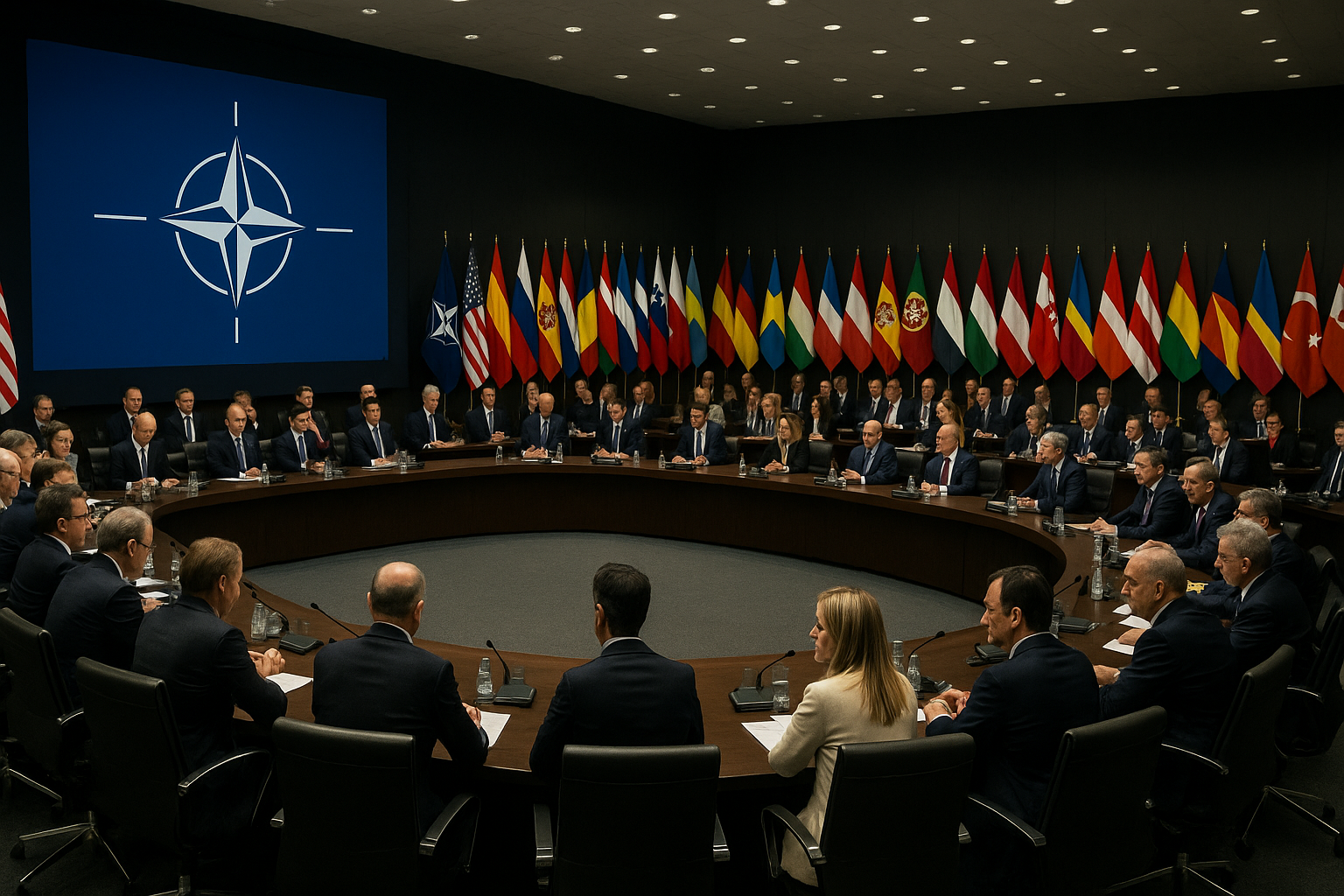In a powerful display of alliance resolve, NATO leaders at the Hague summit committed to significantly expanding defence spending—targeting 5% of national GDP per year by 2035, split into 3.5% for core military capabilities and 1.5% for resilience, cyber defence, infrastructure, and emerging technologies. This sharp break from the longstanding 2 % threshold sets the scene for a bold strategic shift.
The summit also reaffirmed a “quantum leap” in NATO’s posture, endorsed universal support for Ukraine, and sent deterrent signals to both Russia and China.
Why Now? The Perfect Storm of Threats
1. Russia’s Unyielding Aggression
Two years after invading Ukraine, Russia continues an assertive posture—positioning troops at NATO’s eastern fringes, deploying cyberattacks, and using hybrid warfare. This unrelenting pressure drove the alliance’s leaders to move beyond the 2 % standard.
2. Middle East Volatility
U.S.–Israeli airstrikes on Iranian nuclear facilities in June 2025 triggered regional alarms. Even after a fragile ceasefire, the possibility of disruptions to strategic chokepoints, such as the Strait of Hormuz, underscores NATO’s need to guard against more than just European threats.
3. U.S. Pivot to Indo-Pacific
As America refocuses on China, European NATO members face the imperative of assuming greater responsibility. Secretary-General Rutte emphasized Europe must shift to a “wartime mindset,” turbocharged by enhanced defence production and spending.
Trump’s Influence: Disruptor and Driver
Though controversial, former U.S. President Trump played a catalytic role at The Hague. He used blunt pressure—labelling allies as “freeloaders” and threatening Article 5 commitments—to force a reckoning on defence spending. Trump even branded Spain “a problem” from Air Force One over its defence stance.
Despite tensions, many NATO leaders—most notably Rutte—credited Trump for “galvanizing” the alliance, framing his provocations as tough love to spark action.
Unity—and Fracture: European Positions
Champions
- Poland (~4.7 % GDP spend) actively supports the NATO push and aims to be the “transatlantic link” implementing Trump’s challenge.
- The Baltic states are pushing for faster timelines, with Estonia leading the regional alignment.
- Germany, the UK, France, Canada, and the Netherlands have publicly backed the 5% goal, preparing phased roadmap plans.
Holdouts
- Spain stands nearly alone in dissent, defending a 2.1 % cap—arguing that higher spending threatens its welfare state and calling the 5 % target “unrealistic.”
- Belgium, Slovakia, Hungary, and Italy each expressed caution over affordability and aspiration.
Spotlight: Spain’s Defiant Exception
National Context
Despite economic growth and a defence budget increase from 1.28% to 2% by 2025—through budget reallocation and pandemic recovery funds—Spain remains the lowest relative spender in NATO. Sánchez touts the spending as broadly protective and industrially motivated, with benefits directed at domestic welfare and noncombat roles.
Budget distribution under Spanish plans:
- 35 % for troop welfare
- 31 % for telecom and cyber
- 19 % for traditional defence
- 17 % for emergency and disaster response.
Domestic Political Battle
Spain’s coalition—led by Sánchez and backed by minority leftist parties—faces internal strife. His Sumar allies strongly oppose militarization, while critics argue Sánchez is using NATO dissent to distract from domestic scandals. Even the FT notes that his opt-out may be politically calculated amid corruption probes.
NATO Repercussions
Rutte’s concession allowing Spain’s opt-out triggered ire. Poland criticized it as “unjustified,” while others fear it creates a dangerous precedent. Allies stress that flexibility cannot be misused under the banner of national exceptions.
Economic & Defense Landscape
Budget Recalibration
- Germany, France, and the UK must plan to triple defence budgets—massive fiscal efforts ahead.
- Smaller nations with limited budgets will face stark trade-offs between military spending and social development.
Industrial Boom
A surge in demand is expected for AI, drones, cybersecurity, and space systems. Key European defence contractors—Airbus, Rheinmetall, BAE—are gearing up for a decade of accelerated production and R&D.
Strategic Deterrence
This rearmament isn’t purely symbolic. NATO aims to establish 300,000 troops deployable in 30 days, backed by resilient logistics, anti-missile systems, cyber operations, and intelligence sharing.
Phased Timeline & Follow-Up
- By 2035: Achievement of full 5 % capacity
- Mid-term review in 2029: Evaluate progress
- Next summit in 2026 (Turkiye): Assess national budget allocations and military benchmarks.
Annual peer reviews and capability verification will replace formal enforcement—partnership credibility now hinges on reputation.
Risks & Trade-Offs
Alliance Cohesion
Spain’s exception erodes unity. If regions think national circumstances justify a lack of ambition, alliance credibility wanes.
Arms Race Risk
Russia and China may escalate their defence investment in response—a reminder that defence preparedness can also contribute to global militarisation.
Domestic Pushback
In Spain, Italy, Belgium, and other countries, protests highlight the tension between military spending and social welfare—these political battles could delay or dilute the implementation.
Budget vs Delivery
Raising budgets matters, but delivering—on troops, readiness, and tech—is harder. Monitoring and enforcement will be essential.
Strategic Takeaway
- Defensive Dogma Overhaul: A full pivot to multilateral, high-tech deterrence.
- European Self-Reliance: Europe assumes a leadership role amid U.S. reorientation.
- Stoic Summit, Fragile Unity: The 5 % pledge is bold—but Spain’s exception flags future fault lines.
- Defence as Diplomacy: NATO aims to present its defence strength as a complement, not a contradiction, to diplomatic efforts.
FAQs
Q1. Why raise from 2 % to 5 %?
A: The old 2% norm stems from Cold War assumptions. Today’s multifaceted threats—Russia’s aggression, cyberattacks, space risks, and complex Middle Eastern dynamics—demand a more comprehensive approach, funded at 3.5% for warfighting and 1.5% for resilience.
Q2. What falls under the extra 1.5 %?
A: It includes cyber defence, logistics, AI/R&D, satellite systems, public emergency response, and critical infrastructure—essential for sustaining high-end operations.
Q3. Who refuses the target, and why?
A: Spain stands out, arguing social spending would suffer and that flexibility is needed. Belgium, Slovakia, Hungary, and Italy also express budgetary concerns.
Q4. Will countries be penalised for missing the 5 % target?
A: No legal penalties exist—only reputational and strategic consequences. Falling short can reduce a country’s voice and trust in NATO.
Q5. Could it spark a global arms race?
A: It could, as rival powers may respond. NATO counters that credible deterrence prevents conflict by making aggression costlier.
Q6. Are there inflation risks?
A: Yes—defence inflation coupled with energy volatility from Middle East tensions could increase prices, though tech investment may fuel growth to offset it.
Q7. Is Spain isolated?
A: Spain is in the minority but not alone—Belgium and Slovakia share some reservations. Spain’s exception, however, sets a distinct diplomatic marker.
Q8. How will progress be measured?
A: Through annual peer reviews, mid-term benchmarks (2029), and capability targets (deployable troops, cyberinfrastructure). The 2026 Turkey summit will review the rollout of the initiative.
Q9. What’s the timeline?
A:
- 2025–32: Phase increasing from 2 % to 5 %
- 2029: 50 % target review
- 2035: Full implementation goal established
Q10. What happens next?
- National budget revisions
- Procurement plans for defence tech
- Strengthening NATO supply chains and industry co-development
- Continued alliance cohesion work to accommodate national differences
Final Word
NATO’s leap to a 5 % GDP defence commitment marks a strategic turning point—moving from ritual targets to full-scale, tech-enabled defence preparedness. The pledge signals unity and readiness, even as Spain’s dissent exposes deeper tensions between defence and social priorities.
The challenge now isn’t ambition—but execution: turning political promises into deployable forces, responsive infrastructure, and sustained strategic advantage over the next decade.

